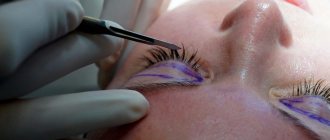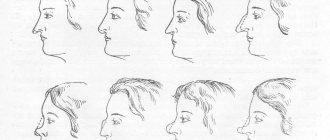Eyelid lift (Blepharoplasty)
The skin of the eyelids is the thinnest and does not contain subcutaneous tissue. With age, collagen fibers become thinner and the skin loses its elasticity. Under the influence of gravity, the skin sagging, wrinkles and folds form. Due to the bulging of fatty tissue in the periorbital region, fatty hernias are formed. Modern cosmetic procedures can delay the development of pronounced age-related changes, but are not able to protect against aging. Plastic surgery on the eyelids - blepharoplasty - will help restore a clear and open, youthful look.
When planning an upcoming aesthetic surgery, it is necessary to consult an ophthalmologist. The presence of eye diseases (increased intraocular pressure, inflammation, glaucoma) is a strict contraindication to blepharoplasty. In addition, surgery is categorically not recommended if general contraindications are identified.
The method of blepharoplasty is determined by the plastic surgeon during the consultation. Depending on the severity of age-related changes and the location of problem areas, lower blepharoplasty (lower eyelid surgery) or upper blepharoplasty (upper eyelid surgery) can be performed. In the event that both the lower and upper eyelids are corrected at the same time, they speak of circular blepharoplasty.
Classic blepharoplasty is performed through incisions in the area of the supraorbital fold of the upper eyelid and/or along the border of the ciliary edge of the lower eyelid. After healing, scars in these areas become almost invisible, and the skillful use of decorative cosmetics completely masks the traces of the surgery.
Classic blepharoplasty is indicated for patients with severe skin changes that extend beyond the orbit and affect neighboring areas. Gentle operations in this case do not give the desired and long-term effect. If necessary, the classic method of eyelid surgery allows for extended intervention. During one operation, through the existing incisions, you can tighten the skin of the forehead, bridge of the nose, and the middle of the face.
If the elasticity of the skin is preserved, and the formation of fatty hernias is caused, rather, by constitutional or hereditary reasons, and not by the destructive effects of time, the operation can be performed transconjunctivally. In this case, the incision is made along the inner surface of the lower eyelid (within the conjunctiva). The scar formed at the site of the postoperative suture will not be noticeable at all.
Completely seamless, laser eyelid correction is performed only for minor changes in the eye skin. Under the influence of laser radiation, microfragments of old skin are removed, small fatty hernias and slight drooping of the upper eyelid (ptosis) can be eliminated. Laser correction is an “intermediate” stage, more effective compared to cosmetic procedures, but less significant in relation to blepharoplasty.
Plastic surgery on the eyelids can be performed to change the shape of the eyes. In particular, with the help of blepharoplasty you can turn an “Asian” eye into a “European” one.
The surgery is performed under local anesthesia. This means that during the operation you will be conscious, but will not feel pain caused by the surgeon’s manipulations. During the operation, the doctor excises excess skin fragments, redistributes fatty tissue, and additionally fixes the muscles of the eyelid. The skin incisions are sutured with special cosmetic sutures. The operation ends with the application of a cooling bandage.
As a rule, the effect of the performed operation lasts for 8-10 years. Long-term preservation of the aesthetic result is largely determined by careful adherence to the recommendations of the plastic surgeon, systematic implementation of cosmetic procedures, and the patient’s lifestyle.
In the early postoperative period, the formation of edema and intradermal hemorrhages (bruises) is inevitable. By the end of the first week after surgery, these phenomena gradually disappear, and only then will it be possible to evaluate the first results of the operation.
During the first time after surgery, the patient may experience mild pain, heaviness of the eyelids, irritation and dry eyes. Conventional painkillers will eliminate the unpleasant pain that blepharoplasty causes. After the operation, swelling of the eyelids also develops, and bruises appear in the area of intervention.
After classical blepharoplasty, the sutures will be removed within 3-4 days.
Sections:
Home Types of operations:
Nose Eyelids
• Structure of the eye • Eyelid lift (Blepharoplasty) • After surgery. Eyelids.
Ear Face Chest Body Reconstructive Surgery
Consultation
Preparing for surgery
Blepharoplasty: questions from patients and answers from a plastic surgeon
Is blepharoplasty recommended for everyone?
Blepharoplasty is an operation, the essence of which is the excision of excess fat and skin around the eyes. In youth, when the skin has not yet lost its elasticity, the eyelids look taut, there are no bags under the eyes or “curtains” hanging over the eyes, but over the years the skin loses its properties, and it is the eyelids that lose their elasticity first of all, since the skin around the eyes is several times thinner than in other areas of the face. In addition, the consequences of health problems, lack of sleep, unhealthy lifestyle and unbalanced diet take their toll: and first of all, we see the consequences of all this on the face, or rather on our eyelids... Swelling, bags, fatty hernias, puffiness appear, the eyes “close”, spoiling the appearance and limiting the view. Blepharoplasty in this case is the only effective solution.
Is it possible to have blepharoplasty at 70 years old?
The older a person gets (we don’t say “woman”, since blepharoplasty is also often done by men), the more indications there are for the operation. Especially if there are problems with both the upper and lower eyelids, there are definitely indications for surgery. Usually, people begin to think about blepharoplasty after 35 years. The peak of operations occurs at the age of 45-55 years. The oldest patient I operated on was a 74-year-old lady . The operation went well, so I can confidently say that you can have surgery at 70 years old!
Is the healing process difficult?
Healing of postoperative wounds occurs within 2-3 weeks. But the healing process does not end there: bruises and swelling will persist for some time. How long the recovery period will take depends on many factors, including the patient's health and age. For some, this process goes quickly - from 2 to 4 weeks, for others - longer, from 4 to 6 months. In rare cases, the rehabilitation period can take up to 1 year. Moreover, bruises always go away faster than swelling: bruises disappear within 2-4 weeks, and swelling can last up to a year!
There is one regularity: the older the patient, the longer the rehabilitation usually takes !
Is the surgery and healing process difficult to bear?
The healing process also varies. Much depends on the patient’s pain threshold, his body, tissue sensitivity and other factors. For some people it heals quickly, for others it takes longer and is more painful. The point is largely in the subjectivity of perception. However, the overwhelming majority of patients who have gone through the recovery period after blepharoplasty describe their sensations as quite tolerable.
Does blepharoplasty affect vision?
No, blepharoplasty does not affect vision in any way.
“The main problem of my patients is a hernia of the lower eyelid. Everyone, without exception, is very afraid to undergo surgery. What advice would you give them and how would you reassure them?”
When patients ask me “Do I need to have surgery?”, I tell them that only you can answer this question yourself. When you see your reflection in the mirror, you see these hernias under your eyes or drooping eyelids, and at the same time you can say with complete confidence that this does not bother you at all and you are completely satisfied with yourself - it means that you do not need surgery! If you see that the operation would not hurt you, but you do not want to agree to it because you are afraid of something, it means that you do not need the operation so much.
If a person thinks that he needs an operation, he, without any motivating work on my part, calls me HIMSELF and comes to me for a consultation , where he asks me all the questions that concern him and receives all the information necessary to make a final decision. It's simple.
The medical ethics of a plastic surgeon are such that only the patient himself must decide whether he needs plastic surgery or not. And we - cosmetologists and plastic surgeons - can only tell the patient that he has indications for surgery, or he does not have such indications (I quite often send patients home from consultation because I don’t see indications for surgery. This, I think , also a necessary ethical part of the work of a plastic surgeon).
Well, the cosmetologist, for his part, can tell the patient about how exactly modern cosmetology can help speed up the rehabilitation process after blepharoplasty and show the results of the surgeons’ work and reviews of happy patients who decided to undergo surgery.
Blepharoplasty, examples of the work of plastic surgeon A.Panaetov:
Blepharoplasty, reviews from patients of A.P. Panayetov:
Blepharoplasty, prices:
Current prices can be viewed on the page “Plastic surgery. Prices."
If you have other questions, you can ask them in the Q&A section.
You can make an appointment for a consultation with plastic surgeon A.P. Panayetov in Moscow by phone (viber, whatsapp) or through the feedback form on the website:








